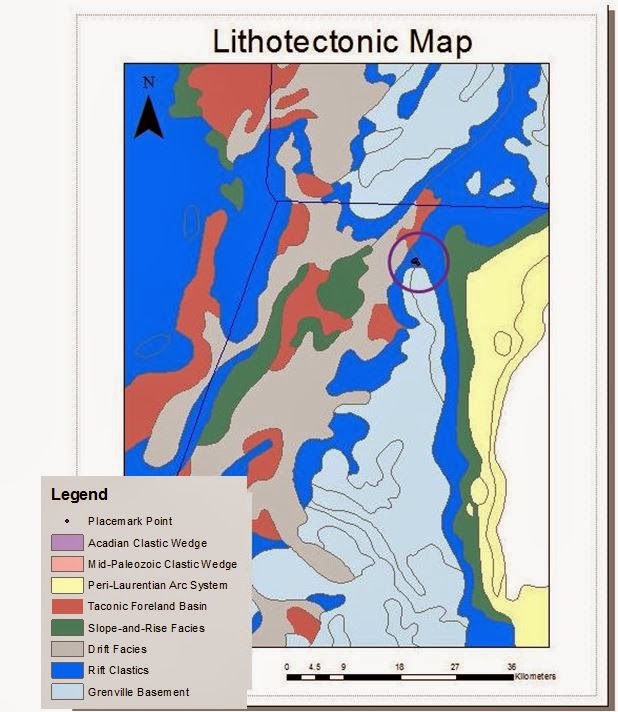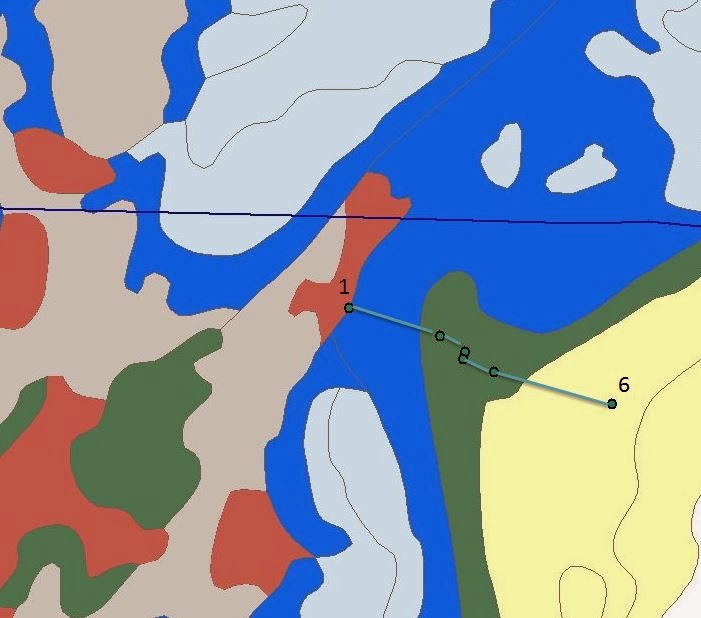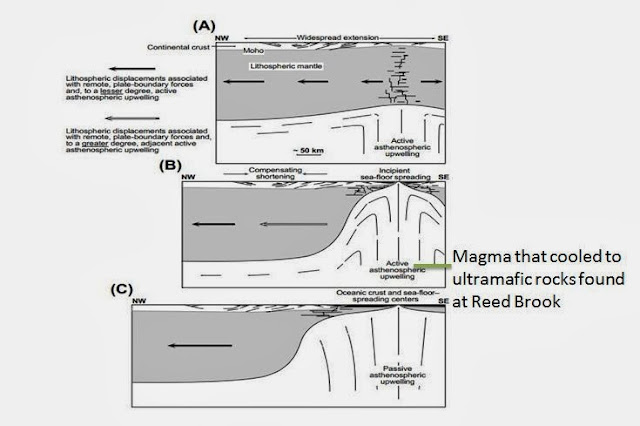Field Trip One
Bennington, VT
September 12, 2013
Mid-Proterozoic
Geologic Context:
In this field trip, we look at rocks that make up the Laurentian Basement (Mesoproterozoic) and the Laurentian passive margin, representing the continental rift to drift transition.
Mesoproterozoic:
1.1 Ga, Grenville Orogeny (Basement rocks)
Neoproterozoic to Early Cambrian:
700 Ma: Post-Grenville rifting
Continental Rift to Drift Transition
Formation description from USGS VT geologic map:
-Fine to medium grained biotite gneiss
-In parts, muscovite and chloritoid present
-Abundant hornblende and amphibolite
-Minor beds of mica schist, quartzite, and calc-silicate granulite
-Pegmatites present along with various meta-granites and metatonalites
-Some characteristics of a calc-alkaline volcanic-plutonic suite
From the geologist's notebook- field notes
-Gneiss, alternating light and dark granite bands
-Light stripes are basement pegmatites, look similar to granite
-Dark stripes are mafic-rich
-Contains minerals: biotite, quartz, feldspars, hornblende
-Strike: 220 degrees (Southwest)
-Dip: 66 degrees (Northwest)
What is gneiss?
Gneiss is a common fabric seen in metamorphic rocks. It has alternating bands of light and dark-colored rocks and is strongly foliated. It is caused by high grade regional metamorphism. When we see gneiss in the field, we know that the rocks have undergone a deformation event that involved high temperatures or pressures.
What exactly is a "fold," and what causes them?
Anticline: Usually created by upfolding/arching, the oldest strata are found in the center
Syncline: Downfolds/troughs, the younges strata are found in the center
 |
| 1.1: Gneiss at Stop 1, outlined in orange is an anticline, a convex-up fold. The lighter-colored rocks are the felsic component, while the darker-colored rocks are mafic, as shown by the green lines. |
The Mount Holly Formation was formed during the Grenville orogeny during the assembly of the Rodinian supercontinent. These are Laurentian basement rocks, the oldest rocks that we see in New England. These rocks experienced deformation during the orogeny that caused them to fold and gave them the gneissic fabric that we see.
Stop 2 (skipped due to inclement weather): Dalton Conglomerate
Neoproterozoic
Interpretation:
The Dalton Conglomerate will be discussed more in the next section, Week 2 Field Trip. Briefly, however, the Dalton overlies the Laurentian basement rocks and represents a slope/rise formation as Laurentia was transitioning from an active to a passive margin. The clasts in the conglomerate were carried by water, giving the formation its random appearance.
Stop 3: Cheshire Quartzite
Cambrian
Formation description from USGS VT geologic map:
-White to pink vitreous (glassy) quartzite
-Near the base, the Cheshire is an argillaceous (contains clay), feldspathic (feldspar-containing) meta-sandstone (the protolith, before metamorphosis, was sandstone). It contains recrystallized quartz and potassium feldspar in a muscovite-biotite matrix
-The Cheshire grades upwards until it is nearly pure quartzite
From the geologist's notebook- field notes
-Extremely pure quartzite that extends from Newfoundland to Georgia in the Appalachian range (though it undergoes a variety of name changes)
-Pinkish-brown in color
-Even texture, smooth surface
-High silica content makes up this pure quartzite
-Asymptotic cross-bedding indicates that the outcrop is right side up
-Some cross-beds truncate at cracks and show bedding planes
-Very erosion-resistant, shapes lanscape
-Rifting causes isostatic ocean transgressions and regressions, making the area tectonically unstable
How are cross-beds formed?
What is quartzite?
Quartzite is a moderate to high-grade metamorphic rock, where sandstone and quartz grains fuse together. Pure quartzite is white, but it can take on a red or pink color if it contains iron oxide. In addition, quartzite can have a banded appearance if the cross-beds are preserved.
 |
| Figure 1.2: Stop 1: View of entire outcrop of Cheshire quartzite, an anticline, shows banded pattern, shown in blue, formed by preserved cross-beds |
The Cheshire Quartzite overlays the Laurentian Basement rocks. It was formed after the Grenville Orogeny, when the post-Grenville rifting had begun and had formed a passive margin on the margin of Laurentia. This passive margin allowed for deposition without subduction. The stability of the shelf environment at this time produced a lot of calcitic rocks, dolomites, and marbles, as well as the Cheshire Quartzite. The Cheshire Quartzite formed on the continental shelf, almost like the "beach" leading up to the Iapetus Ocean. Similar depositions in the Slope/Rise area will be discussed next week.
The Cheshire Quartzite, along with other formations of the Berkshire Massif, were likely thrust Westward during the Taconic orogeny, causing them to overlie the basement rocks in a not-uniform manner.
Optional Stop: Winooski dolomite and Monkton Quartzite
Cambrian
Formation description from USGS VT geologic map:
-Red quartzite interbedded with white quartzite (Monkton quartzite)
-The Monkton Quartzite is interbedded with Winooski Dolomite, relatively thick sections of dolomite
-The quartzites thin to the east
From the geologist's notebook- field notes
-The Monkton quartzite rests on top of a phyllitic quartzite, which rests on top of the Winooski Dolomite
-Winooski Dolomite= Dolomitic marble
-Winooski Dolomite is lighter in color than the Monkton quartzite
-Monkton Quartzite is made up of three different rock types: quartzite, phyllite, and dolomite
-Monkton quartzite/phyllite is highly layered, sheeted
-Monkton Quartzite truncates at fault
-Not an unfonformity because there are truncations on both sides
-Contains a fold facing into the cliff, near fault zone
Interpretation:
Dolomite, like the Winooski Dolomite, are calcium-rich carbonate rocks that are uncommon today. They formed most commonly on ancient seafloors where there was an abundance of sulfate-reducing bacteria. Both the Winooski Dolomite and the Monkton Quartzite were likely formed during the continental shelf sequence, still on the passive margin of Laurentia. Like the Cheshire Quartzite, they were formed in a stable environment that allowed for largely undisturbed sedimentation. At this site, we saw a fault running between the Monkton Quartzite and the Winooski Dolomite. It was recognizable as a fault due to the fact that it truncated at both sides, ruling out an unconformity. During the Taconic orogeny, the Monkton Quartzite was likely thrust over the Winooski Dolomite, also causing the visible fold that we saw at this site.
Stop 4: Bascom Formation
Ordovician
Formation description from USGS VT geologic map:
-Interbedded dolomite, limestone or marble, calcareous sandstone, quartzite and limestone breccia
-Lower Bascom: Irregular dolomite layers
-Middle Bascom: Sandy laminae, thin
-Upper Bascom: Slaty or phyllitic limestone and marble
From the geologist's notebook- field notes
-Highway weigh station
-Giant folds within Outcrop, bot an anticline and a syncline are visible
-Cleavage rotated due to slip
-Two different types of marble result in alternating darker and lighter layers
-The darker layer is clay-rich
-The lighter layer was once limestone, now metamorphosed
-Calcite veins parallel to bedding, precipitated from a river, white in color
What is fault slip?
Most of the time, faults are "locked" into place because the crust that overlies them presses down with a large amount of pressure, sealing fractures together. However, when the energy stored in the rock exceeds the pressure exerted from the crust above, slippage occurs. Fault slip refers tot he amount of displacement along the surface of the fault.
Interpretation:
The marble of the Bascom Formation continue to be a product of the passive margin that produced these highly-calcic rocks. The forms seen at the highway weigh station are a result of extreme deformation during the Taconic Orogeny. A fault can also be seen running through this site.
Interpretation:
The marble of the Bascom Formation continue to be a product of the passive margin that produced these highly-calcic rocks. The forms seen at the highway weigh station are a result of extreme deformation during the Taconic Orogeny. A fault can also be seen running through this site.
In the paper "The Laurentian Margin of Northeastern North America," Allen et al. look at the rifting at rift to drift transition of the Laurentian Margin in the Northeastern Canadian Appalachians.
They write: "North of the transform on the Anticosti platform, thin (<855 m), autochthonous Lower Ordovician shelf carbonates of the Romaine Formation lie unconformably on crystalline basement (Fig. 4)(Lavoie et al., 2005). In contrast, south of the transform on Gaspé Peninsula, deep-water Cambrian clastic deposits of the Orignal Formation (Fig. 4) are overlain by distinctive deep-marine conglomerates (Saint Damase Formation) (Lavoie et al., 2003)." (Allen et al. 2010).
We see a similar model in the New England Appalachians and can use the paper by Allen et al. to further break down the formations and outcrops that we saw on this field trip. Like Allen, we saw a crystalline basement, denoted as "i" in Figure 1.7 below. The basement rocks we saw on this trip belonged to the Mount Holly Formation. Stop 2 of the field trip, although skipped due to inclement weather, was the Dalton Conglomerate, shown on the schematic below as "iii," "fine to coarse clastic sedimentary rocks. The Dalton conglomerate fits this description because the clasts vary in size, and the rock was clearly sedimentary in nature-- the clasts had random orientations that were not parallel to foliations, etc. These deposits could be described as "synrift" because they were deposited during the rifting phase of the basin's history. The shelf deposits, "ii," were seen overlying the conglomerate as the Cheshire Quartzite, which was deposited on the beach-like continental shelf. It was formed during the passive margin phase of Laurentia, close to the continent. Deposits in group iv. will be discussed in the blog post for next week's field trip, which focuses on slope/rise deposits.
In conclusion, Allen et al. write:
"...lateral variations in synrift and postrift stratigraphy reflect along-strike partitioning of the margin into rift segments that differ fundamentally in tectonic framework, subsidence history, and sediment dispersal. Specifically, these characteristics conform to a low-angle detachment model for rifting continental crust, and they constrain the range of acceptable models for continental rifting. Furthermore, continental extension appears to have been punctuated by a shift in spreading centers during the latest Neoproterozoic. The proposed model is consistent with the Iapetan rift along the entire length of the eastern Laurentian margin from Newfoundland to Mexico..." (Allen et al. 2010).
In other words, Allen et al. determine that different parts of the Laurentian basin rifted at different times, dispersing sediment in different ways and creating a dynamic environment with different synrift sediments. This will be seen further next week, when we take a hike through a variety of slope/rise synrift sediments.
 |
| 1.7: Figure adapted from Allen et al. shows stratigraphy of a rift zone, as discussed above |
Photo credit to Eloise Andry
"Earth, an Introduction to Physical Geology, tenth addition," by Tarbuck, Lutgens, and Tasa is used as a reference
"Age and Style of Thrusting in the Berkshire Massif, Massachusetts," Karabinos et al, 2008
"Strain in the Day Mountain Thrust Sheet," Karabinos et al, 2008
Allen, J.S., Thomas, W.A., Lavoie, D., 2010, The Laurentian Margin of Northeastern North American: Geological Society of America

































